Method and system for data mining of very large spatial datasets using vertical set inner products
a spatial dataset and data mining technology, applied in the field of vector operations, can solve the problems of inability to store all the bits in a dataset for a given analysis, inability to use the k-means method for noisy data, and inability to perform a given analysis, etc., to achieve fast and accurate computation, speed up the effect of computation
- Summary
- Abstract
- Description
- Claims
- Application Information
AI Technical Summary
Benefits of technology
Problems solved by technology
Method used
Image
Examples
first embodiment
[0085]Additional datasets with different sizes were synthetically generated based on the original data sets to study the timing and scalability of PSIPs technique of the instant invention. Both timing and scalability were evaluated with respect to data size. In the instant invention, due to a small number of cardinality obtained from the original dataset (1,048,576 records), the dataset was super-sampled by using a simple image processing tool on the original dataset to produce five other large datasets, each of which having cardinality of 2,097,152, 4,194,304 (2048×2048 pixels), 8,388,608, 16,777,216 (4096×4096 pixels) and 25,160,256 (5016×5016 pixels).
[0086]The first performance evaluation was done using a P4 with 2 GB RAM using the first embodiment of the present invention. Synthetic datasets having 4.1 and 8.3 million rows were used to evaluate execution time of the method computing total variation for 100 different test cases. Datasets with a size greater than 8.3 million rows ...
second embodiment
[0088]The timing was also observed with respect to scalability when executing on machines with different hardware configurations using the present invention. The hardware configuration needed to be increased to accommodate the horizontal version of the set inner product calculation on the larger data sets. However, the set inner product for the largest data set could still be computed on the smallest machine (AMD Athlon with 1 GB memory) using the vertical p-tree data structure. Table 6 presents the average time to compute the set inner product using the two different techniques under different machines and figure further illustrates performance with respect to scalability.
[0089]
TABLE 6Average time different hardware configurations.Average Time to Compute Inner Product(Seconds)DatasetHorizontalSize inSGI AltixVertical10242AMD-1 GBP4-2 GB12 × 4 GBAMD-1 GB10.550.461.370.0000821.100.912.080.0000842.151.853.970.0001083.798.480.000101616.640.000102428.800.00010 : Out of memory
[0090]The a...
PUM
 Login to View More
Login to View More Abstract
Description
Claims
Application Information
 Login to View More
Login to View More - R&D
- Intellectual Property
- Life Sciences
- Materials
- Tech Scout
- Unparalleled Data Quality
- Higher Quality Content
- 60% Fewer Hallucinations
Browse by: Latest US Patents, China's latest patents, Technical Efficacy Thesaurus, Application Domain, Technology Topic, Popular Technical Reports.
© 2025 PatSnap. All rights reserved.Legal|Privacy policy|Modern Slavery Act Transparency Statement|Sitemap|About US| Contact US: help@patsnap.com



